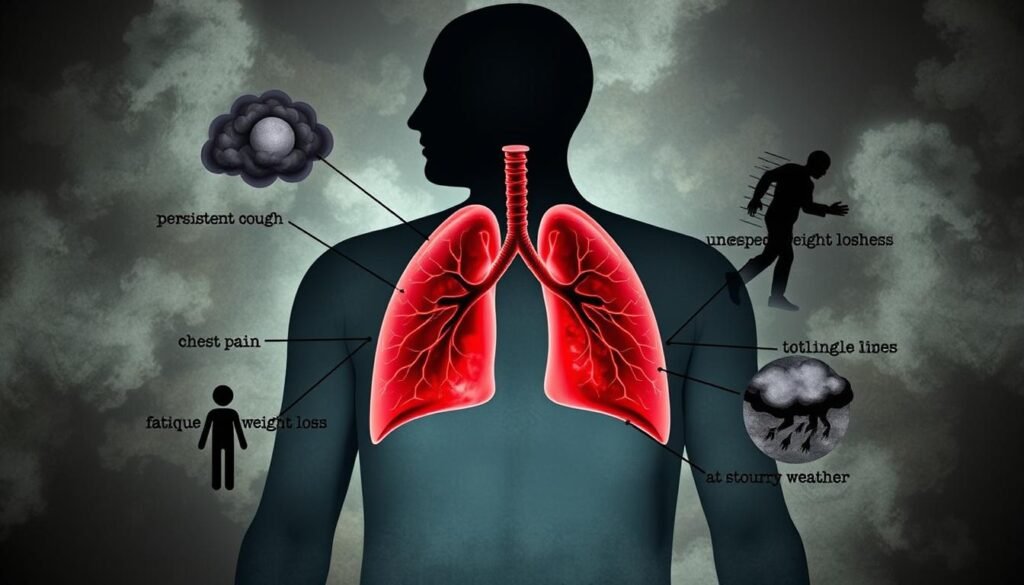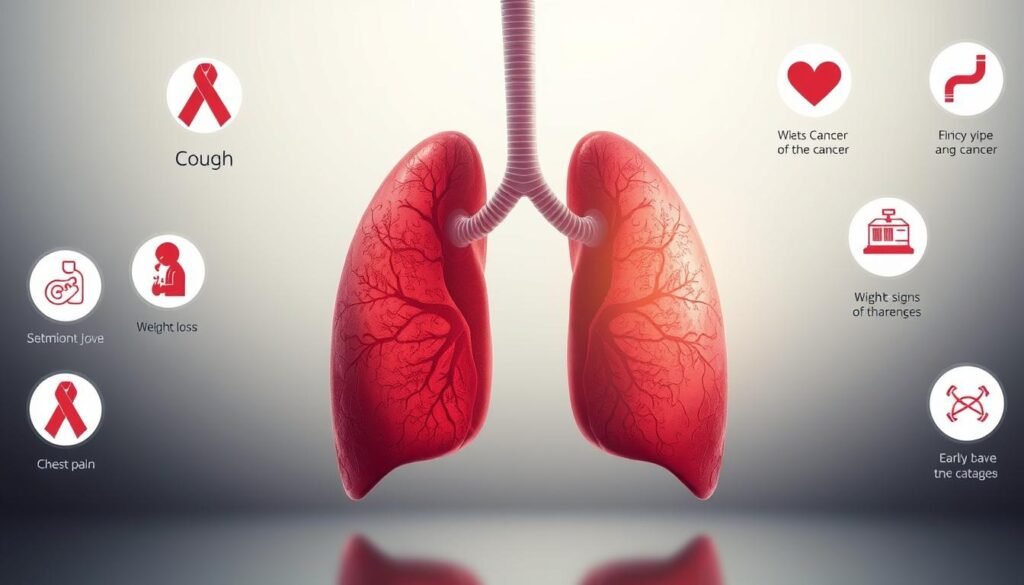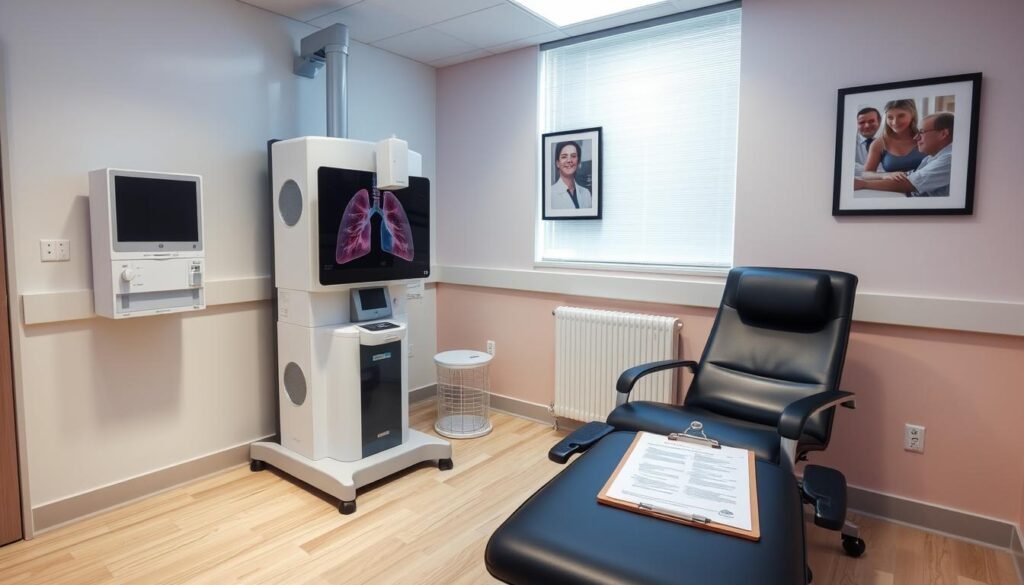Lung cancer leads to nearly 25% of all cancer deaths in the U.S., making it a top killer. Many people don’t know that lung cancer often shows few or no signs early on. This can result in finding out about it too late. Knowing the early signs of lung cancer can greatly increase your chances of getting timely and effective care. It’s crucial for early diagnosis and finding the best treatment options.
Key Takeaways
- Lung cancer is a leading cause of cancer deaths in the U.S.
- Symptoms can be minimal or absent in early stages.
- Timely medical attention can improve treatment outcomes.
- Familiarizing with the 7 signs of lung cancer is crucial.
- Advanced symptoms can impact other organs and systems.
Learn more about the 7 signs of lung cancer. It’s important to talk to healthcare providers as soon as you notice something wrong. This proactive step is vital for your health and wellbeing.
Understanding Lung Cancer
Lung cancer is a major health issue, mostly affecting the lungs. It is split into two main kinds: non-small cell lung cancer (NSCLC) and small cell lung cancer (SCLC). Knowing the difference between these kinds is key. They have different symptoms and ways to treat them.
Several risk factors are crucial in lung cancer’s development. Smoking is the top risk, greatly raising the chance of getting it. Environmental dangers like radon and asbestos also play a big role. So does genetic makeup. It’s important to know these risks. They help point out ways to live healthier and catch the disease early.
As lung cancer gets worse, symptoms can change. One sign could be changes in the nails, like clubbing. Sometimes fingers might look stained from nicotine, a warning sign. Oddly, nearly half of those with lung cancer stop smoking on their own before finding out they’re sick. Early tumors might release substances that help kick the habit. This shows catching the disease early is crucial.
Treating lung cancer depends on the kind you have. Surgery might work for NSCLC if it hasn’t spread much. SCLC might need chemotherapy and radiation therapy. These treatments focus on reducing tumors and easing pain. Knowing the risks and early symptoms is vital for quick action.
For detailed info on lung cancer signs and how to handle them, check out resources like this article on advanced NSCLC symptoms.
Why Early Detection Matters
In the United States, lung cancer is the second most common cancer. It leads to the most cancer-related deaths. Early detection is very important. By getting regular checks with low-dose CT (LDCT) scans, we can greatly increase the chances of successful treatment. These scans are especially recommended for people 50 to 80 who have smoked a lot over the years.
Only 21% of lung cancers get found when they are still local, at stage I. This fact shows how hard it is to catch it early. Knowing the symptoms and getting checked on time can make a big difference. If you’ve smoked a lot, getting checked every year is crucial. It can spot problems in the lungs early on.
Low-dose CT scans use a little bit of radiation, but they save lives by finding cancer early. These scans can point out areas that might be cancer. Doing so can lower death rates and help patients live better lives. Groups like the American Cancer Society push for these early checks. They know how key they are to beating the disease.
People should also talk with their doctors to decide if they need to get screened. Working together helps make sure the decision fits the person’s risk level. Knowing and understanding the guidelines for lung cancer screening is powerful. It lets people take control of their health. This shows how crucial early detection truly is.
7 Signs of Lung Cancer
Knowing the early signs of lung cancer can change outcomes a lot. Being aware of these symptoms helps people get medical help fast. Here are seven key signs to watch out for:
Persistent Cough
A cough that keeps coming back, or gets worse, might be a sign of something serious like lung cancer. While coughing can be a body’s way to clear irritants, it needs quick check-up if it doesn’t go away.
Coughing Up Blood
Coughing up blood, or hemoptysis, is a sign of major health issues, including lung cancer. If this happens, you should see a doctor right away.
Shortness of Breath
Feeling short of breath can mean tumors are blocking the airways. Don’t ignore this symptom, as it might mean lung cancer is getting worse.
Chest Pain
Chest pain that gets worse when you breathe deeply, cough, or laugh can be due to lung tumors. Knowing how often and when the pain happens is vital for doctors.
Hoarseness
If your voice stays hoarse, it could mean lung cancer is affecting nerves of the vocal cords. This change needs looking into, especially with other symptoms present.
Unexplained Weight Loss
Losing weight suddenly without trying can be a scary sign of cancer, including lung cancer. This happens as tumors might use a lot of the body’s energy.
Fatigue
Fighting cancer can make you feel very tired. This kind of tiredness, especially if it doesn’t go away, means you should talk to a doctor.
| Signs of Lung Cancer | Description |
|---|---|
| Persistent Cough | Chronic cough worsening over time |
| Coughing Up Blood | Indicates potential serious health issues |
| Shortness of Breath | Difficulties in breathing due to airway obstruction |
| Chest Pain | Pain that worsens with deep breathing or movement |
| Hoarseness | Changes in voice affecting speech |
| Unexplained Weight Loss | A sudden drop in weight with no effort |
| Fatigue | Persistent tiredness not linked to usual activities |
Common Lung Cancer Symptoms
Lung cancer signs might not be obvious at first. They often stay hidden until the disease gets serious. Knowing these signs is key, especially for those at risk due to things like long-term infections.
Chronic Infections
Getting sick often with things like bronchitis or pneumonia could mean lung issues. These problems can make you feel really tired and weak. It’s important to spot these early to avoid worse health issues.
Knowing how infections affect your lungs helps spot trouble early. If you’re often sick with lung problems, see a doctor. They can check if there’s a bigger issue. For more on lung cancer signs, visit this resource.
Impact of Bone Pain
Sometimes, lung cancer causes bone pain if it spreads. This pain can be a big clue that something’s wrong. It’s crucial to pay attention to new or unexplained aches.
Being aware helps manage the issue better and get help fast. If bone pain worries you, talk to a doctor soon.

Additional Symptoms to Monitor
Spotting extra signs of lung cancer can greatly help with early diagnosis. Common signs include a steady cough and feeling short of breath. Yet, there are other signs that might not seem related at first. Watch out for symptoms like nervous system changes, as they urge for an immediate doctor’s visit.
Here are some symptoms to be mindful of:
- Dizziness or lightheadedness, suggesting problems with the nervous system
- Swollen lymph nodes, usually found in the neck or armpits
- Jaundice, showing possible liver issues, seen through yellow skin or eyes
Knowing these extra lung cancer symptoms can unveil how the illness might impact the body. Changes in the nervous system could mean headaches or sudden weakness. Don’t overlook these signs, particularly if they persist.
For further reading on unexpected lung cancer symptoms, see this helpful article.
| Symptom | Description |
|---|---|
| Dizziness | Lightheadedness indicating potential nervous system changes |
| Lymph Node Swelling | Swelling in neck or armpits, often a sign of metastasis |
| Jaundice | Yellowish skin and eyes indicating liver involvement |
What to Do When Symptoms Appear
Feeling the warning signs of lung cancer can be scary. It’s important to act quickly for the best results. Knowing the symptoms of lung cancer is the first step.
People who have a continuous cough, shortness of breath, or other alarming signs should see a doctor right away. The doctor will look into it and suggest tests if needed. Those over 50 who smoked a lot might need a low-dose CT scan to catch lung cancer early.
When symptoms lead you to a doctor, you might get tests like MRI or CT scans. These find out how advanced the cancer is and help choose the best lung cancer response.

People at high risk for lung cancer need to be proactive in checking their health. Regular check-ups and early finding are key to better treatment results. Treatment for lung cancer may include therapies like chemotherapy and radiation.
There are more options beyond usual treatments. Things like immunotherapy and palliative care can make life better. Talking openly with your doctor lets you know all the treatment options.
Seeing a doctor quickly after noticing symptoms is crucial. It leads to timely help and better health management.
For details on lung cancer signs, go to this resource.
How Lung Cancer Differs by Type
It’s crucial to know the symptoms of lung cancer by type. This knowledge aids in early detection and effective treatment. Lung cancer is mainly divided into non-small cell lung cancer and small cell lung cancer. Each type shows different symptoms, helping us understand how the disease progresses.
Non-Small Cell Lung Cancer Symptoms
Non-small cell lung cancer makes up about 80% of cases. It grows slower than small cell lung cancer. The common signs include:
- Persistent cough
- Shortness of breath
- Chest pain
- Coughing up blood
- Unexplained weight loss
Adenocarcinoma is the most common type of non-small cell lung cancer. It often appears in people who’ve never smoked. Catching these signs early can hugely affect diagnosis and treatment.
Small Cell Lung Cancer Symptoms
Small cell lung cancer symptoms can start suddenly and get worse quickly. It’s mostly linked to smoking and makes up less than 20% of lung cancer cases. Key symptoms include:
- Severe coughing
- Wheezing
- Fatigue
- Swelling in the face or neck
- Loss of appetite
Quickly noticing these signs is key. Small cell lung cancer spreads fast, so urgent action is needed.
Importance of Regular Screenings
Lung cancer screening is crucial for early detection. It greatly improves the chances of successful treatment. About 130,000 people in the U.S. die from lung cancer every year, so understanding the benefits of early screening is key.
Doctors suggest yearly screenings for those 50 to 80 years old with a heavy smoking history. Sadly, only 6% of eligible people go for screenings. Early detection is vital, as it significantly increases survival rates.

If you’re over 50 and smoked heavily, consider getting screened. This includes people who have quit smoking in the last 15 years. Also, anyone with COPD, a family history of lung cancer, or asbestos exposure should think about screening.
| Risk Factor | Screening Recommendation |
|---|---|
| Current Smokers | Yearly lung cancer screening |
| Former Smokers (quit in last 15 years) | Consider screening |
| Heavy Smoking History | Yearly screening recommended |
| Asbestos Exposure | Consult specialist regarding screening |
| Family History of Lung Cancer | Consider screening |
Keep up with annual screenings until health conditions suggest otherwise. Be aware, screenings carry some risks like low radiation exposure. Up to half of those screened will find nodules, which may be cancerous if they grow. Quick action after screening can save lives, especially for early signs of disease. For more on this, check out Common NSCLC Symptoms and Their Impact.
Support Resources for Lung Cancer
Getting a lung cancer diagnosis can be scary. Patient care is key in this tough journey. Many support resources are available to help patients and their families deal with the emotional and logistical challenges of lung cancer.
The American Lung Association offers help for patients, their families, and healthcare workers. They have a Lung HelpLine with free expert advice. You can reach out to them at 1-800-LUNG-USA for guidance.
The LUNGevity Lung Cancer HELPLine gives one-on-one help. It works Monday to Thursday from 10 am to 6 pm ET, and Friday from 10 am to 5 pm ET. Call them at 844-360-5864 for support and practical help.
LUNG FORCE organizes community events around the country. These events raise awareness and support. Patients and caregivers can join, make friends, and share their stories.
If you’re newly diagnosed with lung cancer, the Right Track program offers guidance. They explain treatment options and tips for daily life. This can make your journey a bit easier.
| Resource | Description | Contact Information |
|---|---|---|
| American Lung Association | Offers various support resources for patients and caregivers. | 1-800-LUNG-USA |
| LUNGevity Lung Cancer HELPLine | Provides personalized support for patients and caregivers. | 844-360-5864 |
| LUNG FORCE Events | Community events focused on raising awareness and support. | Visit the American Lung Association website for updates. |
| Peer-to-Peer Mentoring | Pairs patients with mentors for emotional support. | Contact through associated organizations. |
| Financial Treatment Programs | Helps manage financial barriers associated with lung cancer. | Details available through patient advocacy groups. |
Lung cancer support resources are key to improving patient care. Using these tools can greatly help patients and their families’ well-being in difficult times.
Conclusion
Knowing the signs of lung cancer is key for early action and better treatment results. Lung cancer is the top reason for cancer deaths in the USA. This makes raising awareness about it very important.
Some symptoms, like a lasting cough, coughing up blood, and losing weight, can show up six months before finding out you have lung cancer. Still, not many adults get checked for lung cancer. This shows we need to do more to make people aware.
Seeing a doctor for regular checks can greatly improve your chances if you catch it early. Lung cancer is mostly found in older adults. This means we need to keep teaching everyone about the symptoms.
Being informed and taking action helps not only you but everyone in fighting lung cancer. Let’s all work together to tackle this disease.